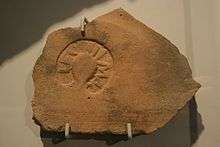Legio IV Macedonica
Legio quarta Macedonica ("Macedonian Fourth Legion"), was a legion of the Imperial Roman army founded in 48 BC by Gaius Julius Caesar (dictator of Rome 49–44 BC) with Italian legionaries. The legion was disbanded in AD 70 by Emperor Vespasian. The legion symbols were a bull (as with all of Caesar's legions) and a capricorn.[1]

History
Early history
This legion was probably founded in Italy in 48 BCE by Julius Caesar, who needed it in his war against Pompey. It saw its first action at Dyrrhachium. After the civil war the legion was stationed in Macedonia. The unit was supposed to serve in Caesar's campaign against the Parthian Empire. Unfortunately, the expedition was canceled after Ceaser's death. Although, the failure of the campaign did not stop the legion from fighting.As another civil war would soon break out. Before this war the legion was moved to Italy by Marc Antony, although this did not deter the legion from siding with Augustus at the Battle of Mutina they fought against Antony and suffered heavy losses.[2]In 42 BC it fought in the Battle of Philippi and returned to the Italy with Augustus.While in it Italy it fought in the Perusian war against Mark Antony's brother Lucius. It was present at during the siege of Perugia.[2] It was also present at the Battle of Actium.[2]
Cantabrian Wars
After Augustus became Emperor, in 30 BC it was moved to Hyspania Tarraconensis to fight the Cantabrian Wars. During the war the legion was stationed at Herrera de Pisuerga.[2] After the war the soldiers continued to serve as civil servants in Hispania.[2]
Early Service in Germania
Most likely Roman emperor Claudius transferred the legion to Mainz in Germania Superior.[2] It is unknown when this happened although it was probably in 41 AD.It replaced XIV Gemina, which was now fighting in Britain. However. Some people think that the legion was transferred in 39 AD, when emperor Caligula waged war against the Germanic Chatti. While stationed in Germania the Fourth shared the fortress with the recently founded XXII Primigenia. The younger unit occupied the less honorable left-hand side, whereas IIII Macedonica was living in the right-hand side.[2]
Year of Four Emperors
When the Year of Four Emperors occurred the Fourth legion and the Twenty-Second were the first to side with Vitellius. Many soldiers of the legion took part in Vitellius' march to Italy. It conquered the road through Switzerland, fought at Cremona against the troops of the emperor Otho. Several soldiers were rewarded for their service and transferred to the imperial guard.[2]
Later service in Germania
Meanwhile, in Germania Inferior, the Batavians revolted. A Roman expeditionary force, consisting of the remains of V Alaudae and XV Primigenia, was defeated near Nijmegen, and not much later, these two legions found themselves besieged at Xanten. Although I Germanica, XVI Gallica and the other legion from Mainz, XXII Primigenia, tried to rescue them, they failed were forced to surrender.Not much later, I Germanica and XVI Gallica surrendered as well.It took several months before the new emperor Vespasian could send a Roman army to suppress the revolt. This army was commanded by his relative Quintus Petillius Cerialis.[2] During the revolt the IV Macedonica guarded Mainz against attacks by Germanic Chatti, Usipetes and Mattiaci. Although it had for some time been successful and fought bravely during Cerialis' campaign, it was guarded with some suspicion by the new emperor. Because of this it was punished as well: it was reconstituted under a new name, IIII Flavia Felix.[2]
Epigraphic inscriptions
- - Caius Valerius Cai filius Voltinia (tribu) Donatus miles legionis IIII Macedonicae annorum XXXIX hic (...). Logrono, Spain. Hisp. Epi. 14626.
References
- Legions and Veterans: Roman Army Papers 1971–2000 By L. J. F. Keppie page 128
- "Legio IIII Macedonica – Livius". www.livius.org. Retrieved 2020-08-04.

